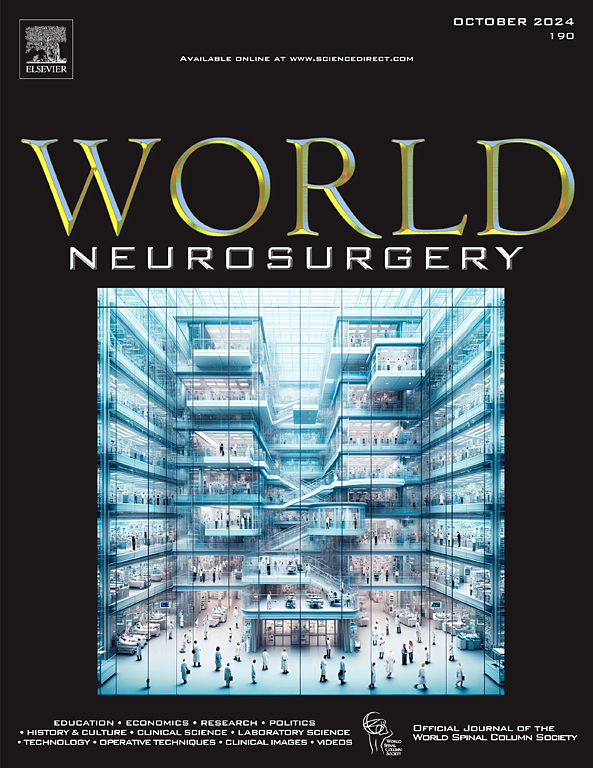单侧与双侧机器人辅助下经皮后凸成形术治疗骨质疏松性椎体压缩性骨折的比较。
IF 1.9
4区 医学
Q3 CLINICAL NEUROLOGY
引用次数: 0
摘要
目的:探讨单侧和双侧机器人辅助下经皮椎体后凸成形术(RAPKP)治疗胸腰椎骨质疏松性椎体压缩性骨折(OVCF)的疗效和安全性。方法:本研究回顾性分析了2020年1月至2022年7月期间接受RAPKP治疗的78例OVCF患者(单侧组48例,双侧组30例)。记录两组患者手术时间、x线暴露时间、骨水泥体积、术后骨水泥分布、术前、术后疼痛视觉模拟评分(VAS)、Oswestry功能障碍指数(ODI)、Cobb角、椎体高度、骨水泥渗漏、相邻椎体骨折(AVF)及术后CT。结果:所有患者均成功接受RAPKP治疗,随访时间(19.90±5.38)个月。结果显示,两组患者术后随访时VAS核心、ODI、椎体高度、Cobb角均较术前显著改善(P < 0.05),双侧组骨水泥注射量(5.93±1.81)mL明显高于单侧组(4.73±0.51)mL (P < 0.05)。单侧组骨水泥渗漏9例(18.75%),双侧组6例(20.00%)(P < 0.05)。未发生神经血管损伤或感染。相邻椎体骨折单侧组8例(16.67%),双侧组4例(13.33%)(P < 0.05)。术后邻椎CT比值(手术椎/上邻椎:单侧:10.65±2.7)两国:11.32±3.1;手术椎体/下邻椎体:单侧:11.67±3.0。两国:12.48±2.9)(P > 0.05)。结论:单侧或双侧RAPKP可改善患者的VAS、ODI、矢状指数和Cobb角。单侧RAPKP具有较少穿刺损伤的优点。尽管如此,双侧RAPKP术后骨水泥分布更好,我们认为双侧RAPKP有更好的长期预后,因此我们推荐双侧RAPKP。本文章由计算机程序翻译,如有差异,请以英文原文为准。
Comparison of Unilateral and Bilateral Robot-Assisted Percutaneous Kyphoplasty in Treating Osteoporotic Vertebral Compression Fracture
Objective
To investigate the efficacy and safety of unilateral and bilateral robot-assisted percutaneous kyphoplasty (RAPKP) in treating thoracolumbar osteoporotic vertebral compression fractures.
Methods
Our study retrospectively analyzed 78 patients (unilateral group: 48, bilateral group: 30) with osteoporotic vertebral compression fracture treated with RAPKP from January 2020 to July 2022. The operation time, X-ray exposure time, bone cement volume, postoperative bone cement distribution, preoperative and postoperative pain visual analog scale (VAS) scores, Oswestry Dysfunction Index (ODI), Cobb angle, vertebral height, bone cement leakage, adjacent vertebral fracture, and postoperative computed tomography (CT) in both groups were recorded.
Results
All patients were successfully treated with RAPKP and followed up for 19.90 ± 5.38 months. Our results showed that the VAS core, ODI, vertebral height, and Cobb angle at postoperative follow-up were significantly improved in both groups compared to the preoperative period (P < 0.05). The operation time in the bilateral group (46.20 ± 6.89 minutes) was not statistically different from the unilateral group (42.54 ± 10.16 minutes) (P > 0.05), while the volume of bone cement injected was significantly more in the bilateral group (5.93 ± 1.81 mL) than in the unilateral group (4.73 ± 0.51 mL) (P < 0.05). In addition, the distribution of bone cement in the bilateral group was significantly better than that in the unilateral group (P < 0.05). There were no significant differences in X-ray exposure dose between the 2 groups (P > 0.05). Bone cement leaked in 9 cases (18.75%) in the unilateral group and 6 cases (20.00%) in the bilateral group (P > 0.05). No neurovascular injury or infection occurred. There were 8 cases (16.67%) of adjacent vertebral fracture in the unilateral group and 4 cases (13.33%) in the bilateral group (P > 0.05). Postoperative CT ratios of adjacent vertebrae (operated vertebra/upper adjacent vertebra: unilateral: 10.65 ± 2.7, bilateral: 11.32 ± 3.1; operated vertebra/lower adjacent vertebra: unilateral: 11.67 ± 3.0, bilateral: 12.48 ± 2.9) (P > 0.05).
Conclusions
Unilateral or bilateral RAPKP improves patients’ VAS, ODI, sagittal index, and Cobb angle. Unilateral RAPKP possesses the advantage of fewer puncture injuries. However, bilateral RAPKP has better postoperative cement distribution, and we believe that bilateral RAPKP has a better long-term prognosis, so we recommend bilateral RAPKP.
求助全文
通过发布文献求助,成功后即可免费获取论文全文。
去求助
来源期刊

World neurosurgery
CLINICAL NEUROLOGY-SURGERY
CiteScore
3.90
自引率
15.00%
发文量
1765
审稿时长
47 days
期刊介绍:
World Neurosurgery has an open access mirror journal World Neurosurgery: X, sharing the same aims and scope, editorial team, submission system and rigorous peer review.
The journal''s mission is to:
-To provide a first-class international forum and a 2-way conduit for dialogue that is relevant to neurosurgeons and providers who care for neurosurgery patients. The categories of the exchanged information include clinical and basic science, as well as global information that provide social, political, educational, economic, cultural or societal insights and knowledge that are of significance and relevance to worldwide neurosurgery patient care.
-To act as a primary intellectual catalyst for the stimulation of creativity, the creation of new knowledge, and the enhancement of quality neurosurgical care worldwide.
-To provide a forum for communication that enriches the lives of all neurosurgeons and their colleagues; and, in so doing, enriches the lives of their patients.
Topics to be addressed in World Neurosurgery include: EDUCATION, ECONOMICS, RESEARCH, POLITICS, HISTORY, CULTURE, CLINICAL SCIENCE, LABORATORY SCIENCE, TECHNOLOGY, OPERATIVE TECHNIQUES, CLINICAL IMAGES, VIDEOS
 求助内容:
求助内容: 应助结果提醒方式:
应助结果提醒方式:


